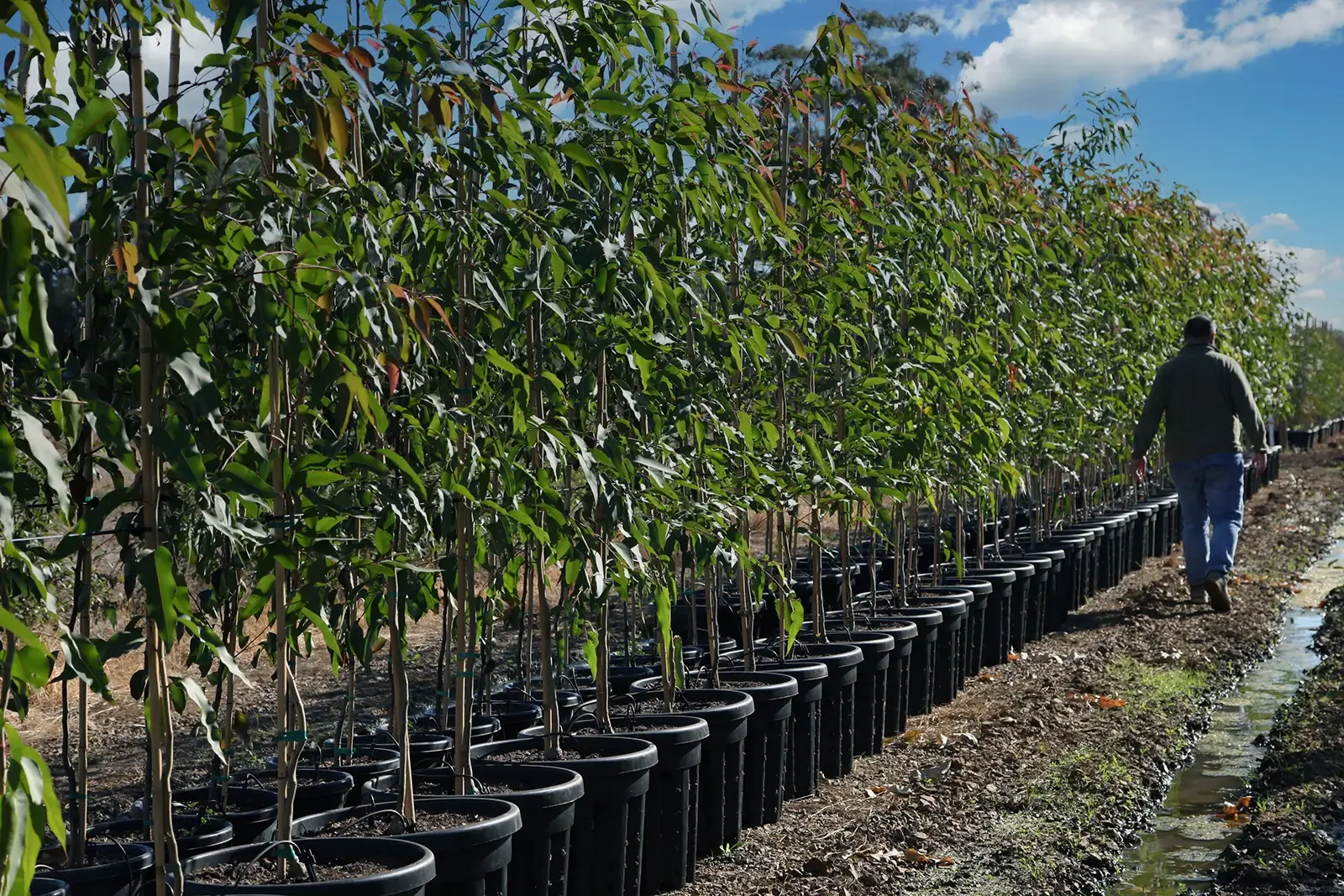Here’s how we keep 90,000m² of trees thriving through summer — without wasting a drop.
See how we prepare for peak season with smart irrigation, Murray-fed dams, and a few tricks of the trade.
Looking for future-ready tree stock? Browse our range or get in touch.
A close call last weekend
Last Saturday, right at midday, one of our irrigation pumps failed.
We had just hit peak heat for the day, and the system went down. If it hadn’t been for our contracted plumbing team jumping on it fast, we would’ve had boots back on the ground on Sunday, watering row by row with a tractor and water tank.
It was a near miss, but a useful one. It reminded us why planning and responsiveness matter so much during this stretch of the season. If it’s 30°C before morning tea, there’s no room for delay.
It’s not even December, and we’re already chasing shade.
Here in Nathalia, the sun hangs long and heavy over the rows.
It’s beautiful to see, but on the Farm, that shift triggers a whole different rhythm on the ground. More checks and early starts, with a sharp eye on the irrigation schedule.
When you’re growing tens of thousands of trees on 90,000 square metres, you have to manage water.
Here’s how we do it.
A river in the paddock
Every drop starts at the Murray.
Like most farms in the region, we operate on allocated water, drawn from the river and delivered via channel.
Our dam fills in pulses – you can almost feel the pressure change when that first rush of water slides through the gates. (We filmed one of those fills recently. It's a good reminder of scale and source).
This on-farm storage is key. It gives us flexibility to irrigate when the trees need it, not just when the river does. And it lets us respond fast during those late-spring heatwaves that catch young trees off guard.
We also operate a closed-loop system: all the water that flows through our irrigation lines drains back into the dam. It means we keep waste to a minimum and every drop is accounted for
Walking the rows
Nothing beats a walk through the rows to check water levels.
Every morning, someone’s checking leaf response, soil feel, and pot weight. Some days, that’s how we spot issues before they spread – a line that’s running dry, or an emitter knocked loose by wind.
It’s also how we fine-tune – if the heat doesn’t arrive evenly, and neither should the water.
Tailored to the root zone
Over the years, we’ve trialled a fair few systems. But the balance we’ve landed on is a mix of drip lines and low-throw micro-sprays.
It lets us adjust for different zones, species, and stages of growth – without soaking everything in sight.
Drip lines handle deep watering, especially for advanced stock.
Micro-sprays cover dense shrub blocks and younger pot lines.
Fertigation keeps nutrition consistent without overloading.
It’s not set-and-forget, but it works. The trees stay hydrated, the roots stay deep, and we don’t waste water fighting evaporation.
If you’re planning summer planting, now’s the time to talk timelines.
When the heat stays high
January is where things get tested.
If we’ve timed things right in November and December, the root systems are strong, and the canopy can handle a bit of pressure. But if we’ve overwatered, underwatered, or mistimed a fertigation, that’s when things show up.
We learned that the hard way a few summers back. A late-November heat spike caught us mid-transition, and a few advanced lots wilted fast.
Since then, we’ve built in earlier checks, quicker adjustments, and more overlap between irrigation cycles.
What it means for tree stock
Consistent irrigation isn’t just about plant health on the farm. It means the trees that leave our gates are:
Rooted deep and stable
Conditioned to real-world heat stress
Less likely to suffer transplant shock
It’s one more reason our stock holds up on civic sites, in new housing estates, and in public landscapes. They’re not just well-grown, they’re also well-watered.
Next steps to keep the trees cool
As we head into high summer, we’re:
Checking and clearing emitters row by row
Fine-tuning fertigation schedules based on stock condition
Monitoring pumps and backup systems more frequently
Reviewing shade placement and pot cooling techniques
It’s all part of keeping the trees strong, healthy, and ready for delivery – even when it’s 40°C in the paddock.
Need trees that can handle the heat?
We’ve built our systems to keep growing through the heat, so you can plant with confidence.
If you’re planning summer or autumn projects, now’s the time to line up supply.
Get in touch to secure your stock or chat timelines.


